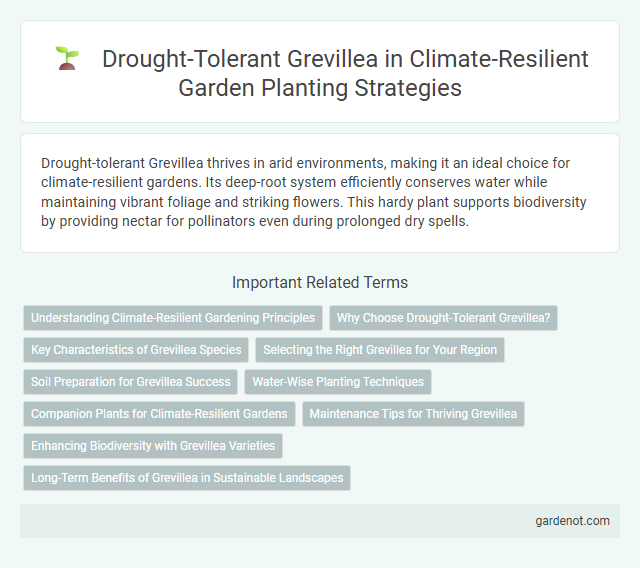Drought-tolerant Grevillea thrives in arid environments, making it an ideal choice for climate-resilient gardens. Its deep-root system efficiently conserves water while maintaining vibrant foliage and striking flowers. This hardy plant supports biodiversity by providing nectar for pollinators even during prolonged dry spells.
Understanding Climate-Resilient Gardening Principles
Drought-tolerant Grevillea species exemplify climate-resilient planting by requiring minimal water and thriving in nutrient-poor soils, making them ideal for sustainable gardening in arid regions. Their deep root systems enhance soil stability and moisture retention, reducing erosion and conserving water resources crucial for adapting to unpredictable climate patterns. Incorporating Grevillea into landscape designs supports biodiversity by attracting native pollinators while promoting long-term ecological balance under increasing drought conditions.
Why Choose Drought-Tolerant Grevillea?
Drought-tolerant Grevillea thrives in arid and semi-arid climates, requiring minimal water once established, making it ideal for climate-resilient planting. Its deep root systems enhance soil stability and reduce erosion, contributing to sustainable landscaping in drought-prone areas. This native Australian shrub also supports local biodiversity by providing nectar for pollinators during dry seasons.
Key Characteristics of Grevillea Species
Grevillea species exhibit remarkable drought tolerance due to their deep root systems and leathery, narrow leaves that reduce water loss. These plants thrive in nutrient-poor soils and exhibit rapid recovery following dry spells, making them ideal for climate-resilient landscaping. Their diverse flowering patterns also support local pollinators, enhancing ecosystem stability in arid environments.
Selecting the Right Grevillea for Your Region
Selecting the right drought-tolerant Grevillea species for your region involves considering local climate conditions, soil type, and water availability to ensure optimal growth and resilience. Species such as Grevillea robusta and Grevillea rosmarinifolia thrive in dry environments and are well-suited for arid and semi-arid regions due to their low water requirements and deep root systems. Matching Grevillea varieties to specific regional climate zones promotes sustainable landscaping practices and enhances long-term climate resilience in drought-prone areas.
Soil Preparation for Grevillea Success
Drought-tolerant Grevillea thrives in well-drained, sandy or loamy soils rich in organic matter to ensure optimal root development and moisture retention. Preparing the soil by incorporating compost and coarse sand improves aeration and nutrient availability, enhancing the plant's resilience to prolonged dry spells. Avoid heavy clay soils and ensure pH levels remain slightly acidic to neutral, promoting healthy growth and drought resistance.
Water-Wise Planting Techniques
Drought-tolerant Grevillea species thrive in low-water environments, making them ideal for water-wise planting techniques that focus on soil moisture conservation and efficient irrigation. Incorporating organic mulch layers around the root zone reduces evaporation and enhances water retention, supporting the plant's resilience during dry periods. Strategic placement in well-drained soil combined with drip irrigation systems optimizes water use while promoting healthy growth and sustainability in drought-prone landscapes.
Companion Plants for Climate-Resilient Gardens
Drought-tolerant Grevillea thrives alongside companion plants like Kangaroo Paw, Bottlebrush, and Flannel Flower, which share similar water-efficient adaptations and soil preferences. These plants collectively enhance garden resilience by maintaining biodiversity and supporting native pollinators in arid climates. Combining Grevillea with deep-rooted grasses and succulents further stabilizes soil moisture and reduces irrigation needs in climate-resilient gardens.
Maintenance Tips for Thriving Grevillea
Drought-tolerant Grevillea thrives best in well-drained soils with minimal watering once established, making it ideal for climate-resilient planting. Regular pruning after flowering encourages bushier growth and prevents legginess. Mulching around the base conserves moisture, suppresses weeds, and helps maintain consistent soil temperatures for optimal health.
Enhancing Biodiversity with Grevillea Varieties
Drought-tolerant Grevillea varieties enhance biodiversity by providing essential habitat and nectar sources for native pollinators such as birds and insects, even in arid environments. These resilient plants support ecosystem stability by promoting soil health and reducing erosion through their extensive root systems. Cultivating diverse Grevillea species contributes to climate-resilient landscapes that thrive under water-scarce conditions while sustaining local wildlife populations.
Long-Term Benefits of Grevillea in Sustainable Landscapes
Drought-tolerant Grevillea species offer exceptional long-term benefits in sustainable landscapes by conserving water and reducing irrigation needs. Their deep root systems improve soil stability and enhance nutrient cycling, promoting healthier ecosystems over time. Integrating Grevillea into urban and rural settings supports biodiversity while providing resilient green spaces amid changing climate conditions.
Drought-tolerant grevillea Infographic

 gardenot.com
gardenot.com